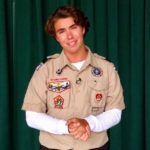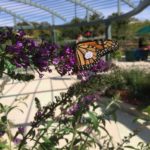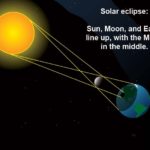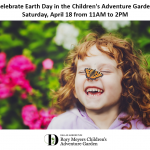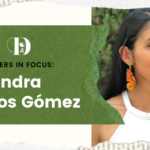STEM Careers in Focus: T’Noya Thompson
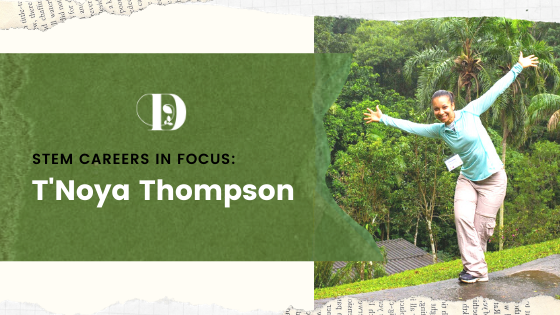
We are back with the sixth, and final, installment of our first STEM Careers in Focus series! Today’s interview by Dustin Miller, director of experience and innovation, features a conversation with international environmental educator, T’Noya Thompson. A long-time Texas resident, hailing from The Bahamas, T’Noya’s message is simple for young people interested in STEM careers: “have conversations, cultivate relationships, and reach out.”
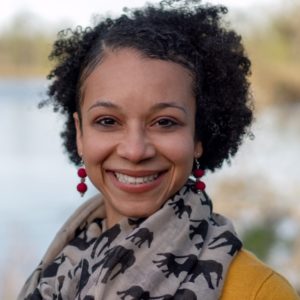
Dustin Miller (DM): You grew up in the Bahamas. Tell me about your connection to the natural world as a kid.
T’Noya Thompson (TT): I feel very fortunate to have been born in such a beautiful country. As a kid, my favorite days were beach days. Any time I could be underwater, exploring, and pretending, I was happiest. I am not sure exactly what I was so drawn to, but I already started gravitating to marine life and ecosystems at three. If there was a book, I read it. If there was a show, I watched it. If there was a zoo or aquarium, I begged to go there. If it swam or crawled, I wanted to get closer for a better look. My Mom was always my biggest supporter and encourager, even if she didn’t understand why her daughter was so interested. My childhood had many ups and downs, but the connection and drive to this career path never wavered. I genuinely believe that it is my mission to connect with others and foster stewardship for our natural world. Perhaps, that is the reason why I have always felt both in awe and at home in nature.
DM: How did you stay connected to the ocean after moving to Texas?
TT: When my family moved to Texas, I felt excited, but a little like a “fish out of water.” The one thing that helped was connecting to the closest aquarium, Moody Gardens, to volunteer at age 16. Also, I became a volunteer at the Texas Marine Mammal Stranding Network as well. I then discovered that I was a 45-minute drive away from one of the best marine biology undergraduate programs housed at Texas A&M University, Galveston. Over time, I appreciated being on the coast and having these opportunities. It was different but in the right way.
DM: Did you have any nature/environmental science role models growing up?
TT: To be honest, I didn’t have that one person or even a few people. I feel like I had many pieces from many people and, over time, put those pieces together. I learned from people I knew and didn’t know. I leaned on family, friends, and teachers. I watched people that had joy and impactful leadership. I continue to connect with people that intentionally and continuously grow in and outside the field. I continue to learn and grow. And, myself. I learned from failing, trying, and cultivating my faith and purpose along the way. Today, I have several mentors and colleagues that are very inspiring. But I believe we are all fearfully and wonderfully made.
DM: Tell me a bit about your work at Moody Gardens.
TT: Moody Gardens Aquarium and Rainforest was a significant part of my life for so long and continues to be close to my heart. I went from being a volunteer for a few years to an intern in my last college semester. During that last semester, as I was finishing up an internship with the Penguin/Pinniped (mammals with fins or flippers) department, I was encouraged to apply for a biologist position. Thankfully, I got the job and began two days after I graduated, which was pretty amazing.
I worked in the Penguin/Pinniped Department for five years and then transferred to the Rainforest Department as a Senior Biologist, and eventually, the role of Assistant Behavior Management Coordinator over eight years. Throughout the 12 years there, I worked with many amazing animals, people, and projects. From planning conservation fundraisers through the Galveston Chapter of the American Association of Zoo Keepers (GCAAZK) to training Komodo dragons and Giant river otters to presenting at conferences all over the county, I learned so much.

(Pictured above: Thompson working with Hendrix, her favorite Northern rockhopper penguin at Moody Gardens Aquarium)
During my time on staff, I also served a term as the GCAAZK President for a period. Ten years as a member of the National AAZK Professional Development and Conservation Committees and attended the Association of Zoos and Aquariums (AZA) school through being awarded the Disney Animal Kingdom’s Diversity Advancement Scholarship.
I feel very blessed to have had the opportunity to fail, succeed, and grow during these impactful 12 years at Moody Gardens. I would like to thank Paula Kolvig, Diane Olsen, Marci Hoffman, Greg Whittaker, and Robert Callies for being integral people in my life and growth at Moody Gardens.
DM: Can you share your experience with Project Dragonfly’s Global Field Project?
TT: “The Global Field Program (GFP) is a part-time master’s degree program that brings scientists, educators, community leaders, and others together at wildlife conservation hotspots in Africa, Asia, Australia, and the Americas for firsthand experience with inquiry-driven education, environmental stewardship, and global understanding.”
This degree shifted my trajectory, and I will forever be grateful. I was at an AAZK Conference in 2015, and I had the privilege of hearing a keynote presentation from Jenny Gray, CEO of Zoos Victoria. After her presentation, I felt this urge, almost like a tug that I wanted to try something different, and I needed to push out of my comfort zone. I began looking for programs to help me advance and found the GFP program. It was the perfect fit as I was a new working mother.
Once I was accepted, I began an adventure of learning and exploring. There is three 10-day study abroad trips that you take each summer over the two and a half years. I went to Baja California, Brazil, and Mongolia. Each trip, I met amazing people, was immersed in beautiful cultures, and connected to ecosystems. My skills increased, and my network widened. After only a year in the program, I made the hard decision to apply for a position with the Galveston Bay Foundation.
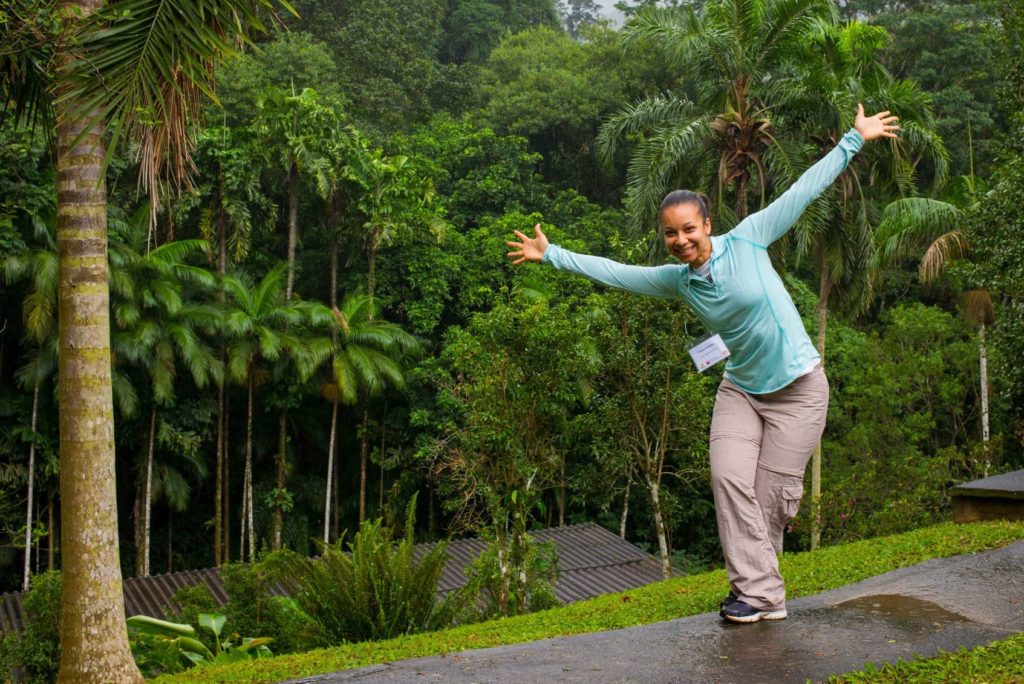
(Pictured above: Global Field Program QUEST in Brazil, Earth Expeditions 2017)
After I graduated in December of 2018, I applied for and hired to be Community Learning Leader for Miami University’s Project Dragonfly’s Global Field Project Program. Through those connections, I now serve as a new board member and the Strategic Initiatives Advisor for the Vermilion Sea Institute, which I was introduced to on my first GFP trip to Baja.
The simplicity of telling people that you are interested in connecting and becoming involved is often overlooked. In fact, at this point, I started to realize the importance of simple conversations.
DM: What was your most important contribution to the Galveston Bay Foundation?
TT: At Galveston Bay Foundation (GBF), I started as the Report Card Coordinator. I managed the Galveston Bay Report Card (GBRC), an annual analysis of the overall health of Galveston Bay. This project is a partnership between GBF and Houston Advanced Research Center (HARC). HARC collected and analyzed the data, and GBF conducted project management, outreach, and implementation.
In this role, I managed the project, engaged with the community, and developed programs to support its growth. When I started, the GBRC had only launched two report cards thus far. Being a relatively new project and a new non-profit project manager, I worked with the GBF and HARC teams to create a brand to establish consistency. I tried many things, talked with numerous people, and explored countless ways to grow this vital resource’s reach. It was a team effort, and I was thankful for contributing failures and successes to expand the GBRC.
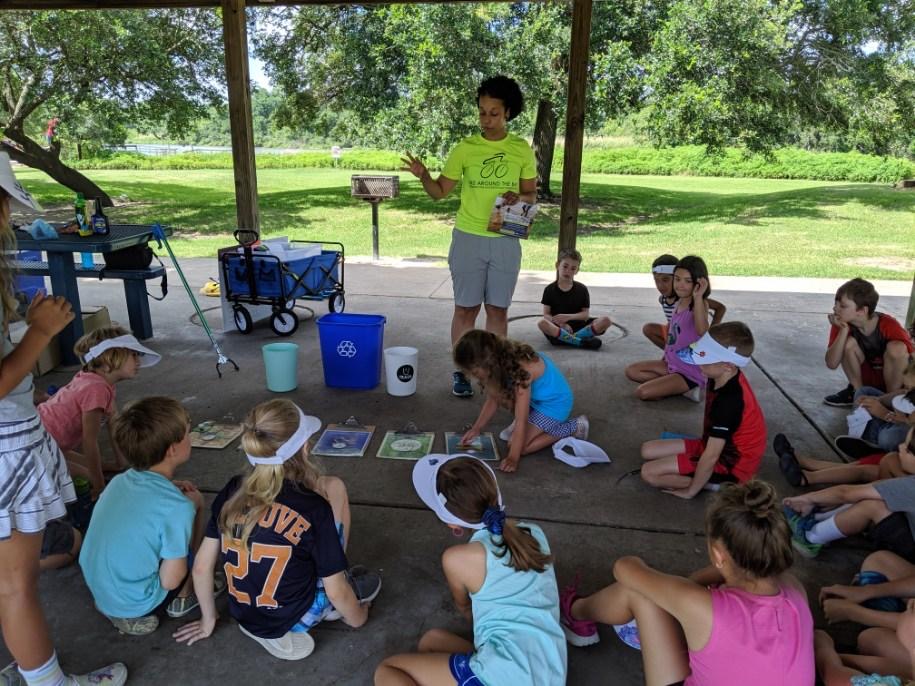
(Pictured above: Thompson presenting at the Galveston Bay Foundation)
DM: You’re a fellow in the Emerging Wildlife Conservation Leadership (EWCL) Program. Congratulations! Can you share about the program?
TT: “EWCL is an initiative that brings together 20-25 emerging leaders in the wildlife conservation field, for capacity building and intense training in campaign development and skills, including implementation of a two-year group international wildlife issue campaign.” I am in Class 8 of the program, and I feel very fortunate to connect with many exceptional individuals.
A big thank you to the EWCL Board of Directors for developing a life-changing program!
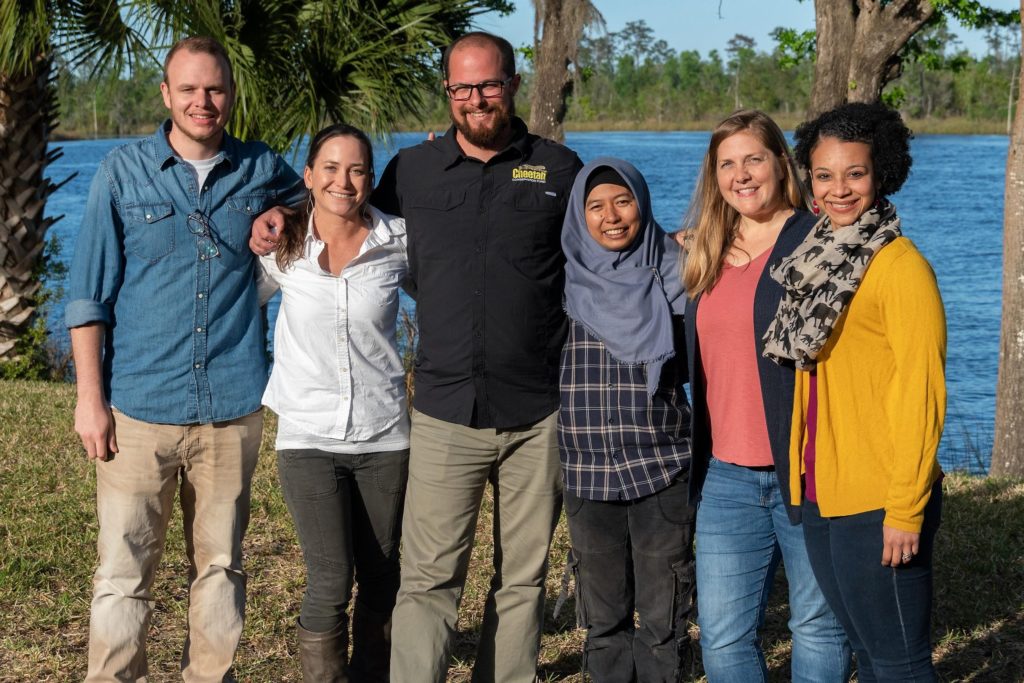
(Pictured above: Thompson’s EWCL Team; (from left to right) Alex Goetz, Indah Sari, Jenna Duarte, Justin Birkoff, Robyn Johnson, and Thompson)
DM: What does your project focus on?
TT: Our EWCL group comprises six conservation professionals from the following organizations: Running Wild Media, Planet Indonesia, Intertwined Conservation Corporation, Cheetah Conservation Fund, Disney’s Animal KingdomⓇ, and The North American Association for Environmental Education.
Project Summary
The Sumatran rhino (Dicerorhinus sumatrensis) is the most critically endangered of all rhino species. Fewer than 80 Sumatran rhinos remain in the wild in several small, highly fragmented populations. In 2018, the Sumatran Rhino Alliance was formed between the Government of Indonesia and relevant NGOs to create a multi-pronged approach to saving the species. Conservation strategies now recognize that the Sumatran rhino’s long-term viability rests on the ability to relocate isolated individuals into managed breeding centers while simultaneously protecting wild populations and habitat.
As part of the ongoing efforts to reinforce the wild population, there are seven Sumatran rhinos housed at the Sumatran Rhino Sanctuary (SRS) in Way Kambas National Park, managed by Yayasan Badak Indonesia (YABI) and funded by our project partner, the International Rhino Foundation (IRF). The managed population at the SRS has successfully produced two calves in the last seven years. In September 2019, an expansion to the facility was completed for housing up to 12 rhinos.
One of the most critical initiatives for the Sumatran Rhino Recovery plan’s continued success and the SRS breeding center is to increase community participation in habitat restoration and supplemental browse propagation programs. Thus, we are focusing our group efforts on the following:
- INSPIRE: Compile a pre-workshop resource kit to be disseminated into the 40 villages surrounding Way Kambas National Park, highlighting the value of the Sumatran rhino and the impact of the community restoration and fodder programs.
- CONNECT: Develop short films highlighting the plight of the Sumatran rhino, the pride local farmers in villages around Way Kambas have for their environment, and, eventually, the impact of participation in the workshop and restoration efforts.
- ENGAGE: We will create a local “rhino university” community workshop to convene local leaders and other community stakeholders (timing dependent on COVID19 restrictions). Participation will facilitate a call to action for the survival of the Sumatran rhino species, including mutually- beneficial participation in the rhino browse and reforestation project in Way Kambas National Park.
- EVALUATE: We will compare community participation levels after the resource kit and workshop and use naturalistic observation evaluation techniques to assess the workshop’s impact and share it with our project partner, the International Rhino Foundation.
DM: You shared that networking in EWCL ultimately led to your position at the North American Association for Environmental Education (NAAEE). Can you talk about the value of building a professional network?
TT: At our first in-person training in March of 2019, I spoke with Judy Braus, the Executive Director of NAAEE, after her presentation. At that point, I had been an NAAEE member and had presented at two of their national conferences. After talking about career goals, she suggested that I get involved more with NAAEE and requested my resume (Word of Advice: Always have your resume updated and ready). I ended the conversation by thanking her for taking the time to talk with me and my appreciation for all of her work in environmental education. She responded, “I would love to get you to work with us at some point in some way!”
After the training, I followed up with Judy, and she invited me to join NAAEE’s Advisory Council. I attended one meeting that summer and was thankful to be connected to this outstanding professional group. Later that fall, I reached out to Judy for some advice and mentorship (a valuable practice that I encourage), and as we talked, she mentioned a position that they were in the process of hiring. That night, I decided to apply for it. I was not looking for a job, but this opportunity seemed like an unexpected and generous fit. Two interviews and intense weeks later, I was offered the position. I think I was feeling a mix of shock and happiness at the time, along with an overwhelming sense of gratitude and peace.
It is so important to have conversations, cultivate relationships, and reach out. I believe the simplicity of this can be overlooked in career development. With the tools and technologies available now, it is easy to connect and reach people worldwide in seconds. And kindness and thankfulness go a long way. Being unique is something that everyone can do—a significant part of building your professional network. Don’t ever let complexity stifle your growth.
“If you are not intentionally preparing for growth, you’re unintentionally preparing for decline.” –Craig Groeschel
DM: Can you share about the NOAA eeBlue Grant and your work within the program?
TT: The North American Association for Environmental Education (NAAEE), in partnership with the National Oceanic and Atmospheric Administration (NOAA) and supported by the U.S. Department of Education, to provide enriching after school watershed-related STEM (science, technology, engineering, and mathematics) projects. These grants will support programming for 91 local 21st Century Community Learning Centers (21st CCLC) sites and their students, many of whom live in high-poverty and underserved areas. The 29 selected projects are serving 17 states, ranging from Alaska to Florida.
These Watershed STEM Education Partnership Grants allow environmental education organizations to collaborate directly with the 21st CCLC sites to design and implement locally relevant, out-of-school-time programs that develop students’ environmental literacy and leadership skills as they improve their communities. My role is to co-manage the grant program alongside NOAA, support the Grantees throughout their program implementation, and streamline the communication between all the partners and teams. It is truly a rewarding role as I enjoy supporting others and this vital work. The Grantees began projects on June 1st, and we are so excited to work with these fantastic partners!
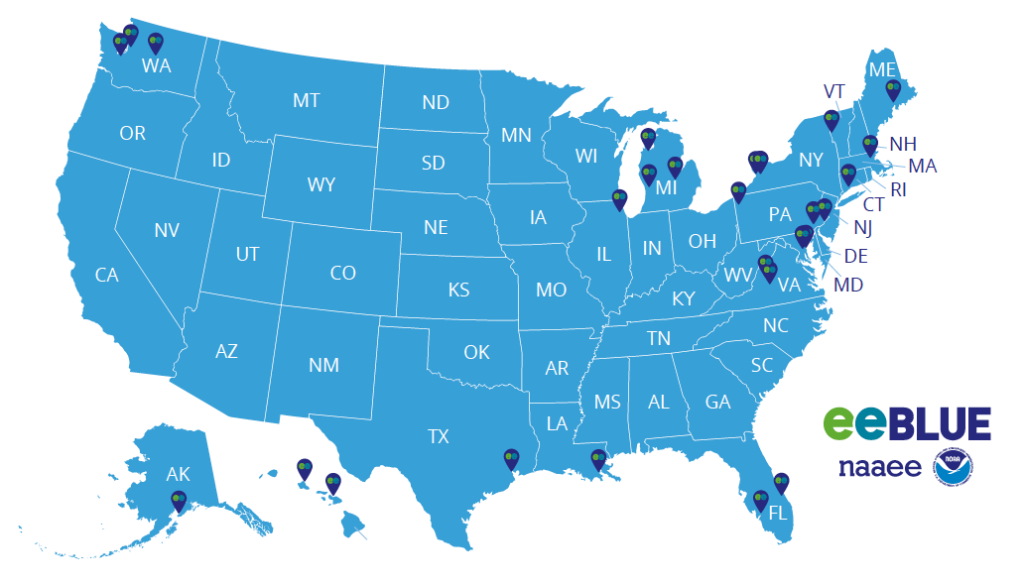
(Pictured above: The 29 Watershed STEM Grantee organization locations)
DM: We teach our visitors about a sit spot – your place in nature to observe the world around you. Do you have a place that you visit frequently?
TT: I have some favorite spots worldwide. Taking time to sit, listen, breathe, think, and be in nature, is truly a blessing. If you can find a tree, patch of grass, pond, etc., you have a sit spot.
Try a Sit Spot in Your Neighborhood
DM: How can we support families in connecting with the world around them?
TT: I believe it is important to have conversations and learn about what people value. We are not all motivated or interested in the same things. We don’t have the same barriers and benefits, meaning we all have different experiences, challenges, and resources that shape what motivates and benefits us. We don’t have to go to a beautiful country or on an excursion to connect to nature. It can start with a potted plant. It can start right in your backyard or your neighborhood. It can begin on a walk to a park. Not everyone has access to green spaces, but we can all work together to change that and encourage educators to listen to all community voices.
DM: How can we better support diverse young professionals to have long-term careers in informal science/conservation?
TT: At times, my family didn’t know what to make of my career path and choices. They were encouraging and supportive, but they didn’t understand what I would do and didn’t know how to help me navigate to get there. Because this career path is not often very understood, and young professionals are navigating as they go. Many are often moving slower on the career path due to not having as many opportunities or being aware of options. It’s not an ideal career either, because the compensation tends to start (and often continue to be) shallow. Passion for a specific job can often be a luxury.
I didn’t realize how much representation mattered until I had my daughter. For me, I just did it and figured it out because there was a purpose that was always an exact driver for me (a blessing). As I continue to grow in the field, as I have done programs with kids and talked with many young professionals, I realize it matters. I feel blessed to be a part of this change, and I am looking forward to moving forward together as we support people of color equitably and become more inclusive in STEM fields.
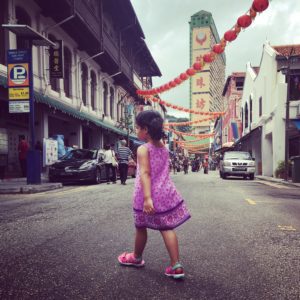
(Pictured above: Thompson’s daughter explores Singapore)
DM: When you go home to visit family, what is on your must-do list?
TT:
- Visit all of my family!
- The BEACH!
- Eat all of the good food, specifically stew fish and johnnycake at The Cricket Club.
- Adastra Gardens, the first zoo I ever visited.
- Blue Lagoon, Island Day Trip
DM: What is your favorite SCUBA spot? Best sighting?
TT: The Bahamas, of course! There are so many islands I still haven’t had the chance to dive, but I will get there.
The best sighting was in Bahia De Los Angeles, Mexico where I have had the honor to share space with the gentle giants of the sea, Whale sharks. Snorkeling and watching those beautiful creatures swim by will never get old. If you ever have the chance, take a trip there through the Stars to Sea citizen-science program that VSI offers. It’s an amazing experience!
We don’t have the same barriers and benefits, meaning we all have different experiences, challenges, and resources that shape what motivates and benefits us.
DM: What’s next on the horizon?
TT: Through community engagement and environmental education, cultivating conservation stewardship has been my heart’s desire for years. Like the ocean, my purpose has always been mostly clear, becoming more apparent over time. Different life events help make things clear or cloudy, but eventually, there is clarity and peace. Either way, I am thankful for God’s plan to continue to light my path, whether by a lamp at times, or full-on light. Day by day, I desire to share love, joy, peace, patience, kindness, goodness, gentleness, and self-control in all that I do. What happens along the way, I am grateful.
“If you want to go fast, go alone. If you want to go far, go together.” African proverb
Read our previous STEM Careers in Focus interviews:
Tony Hale: documentary editor and filmmaker
Jungle Jordan: online science personality
Alejandra Ramos Gómez: teacher/artist/activist
Jacie Hood: Rory Meyers Children’s Adventure Garden Program Manager
Rick Torres: Texas Parks & Wildlife Ranger
Written by Dustin Miller, director of experience & innovation at the Dallas Arboretum
Related Posts
Comments are closed.


